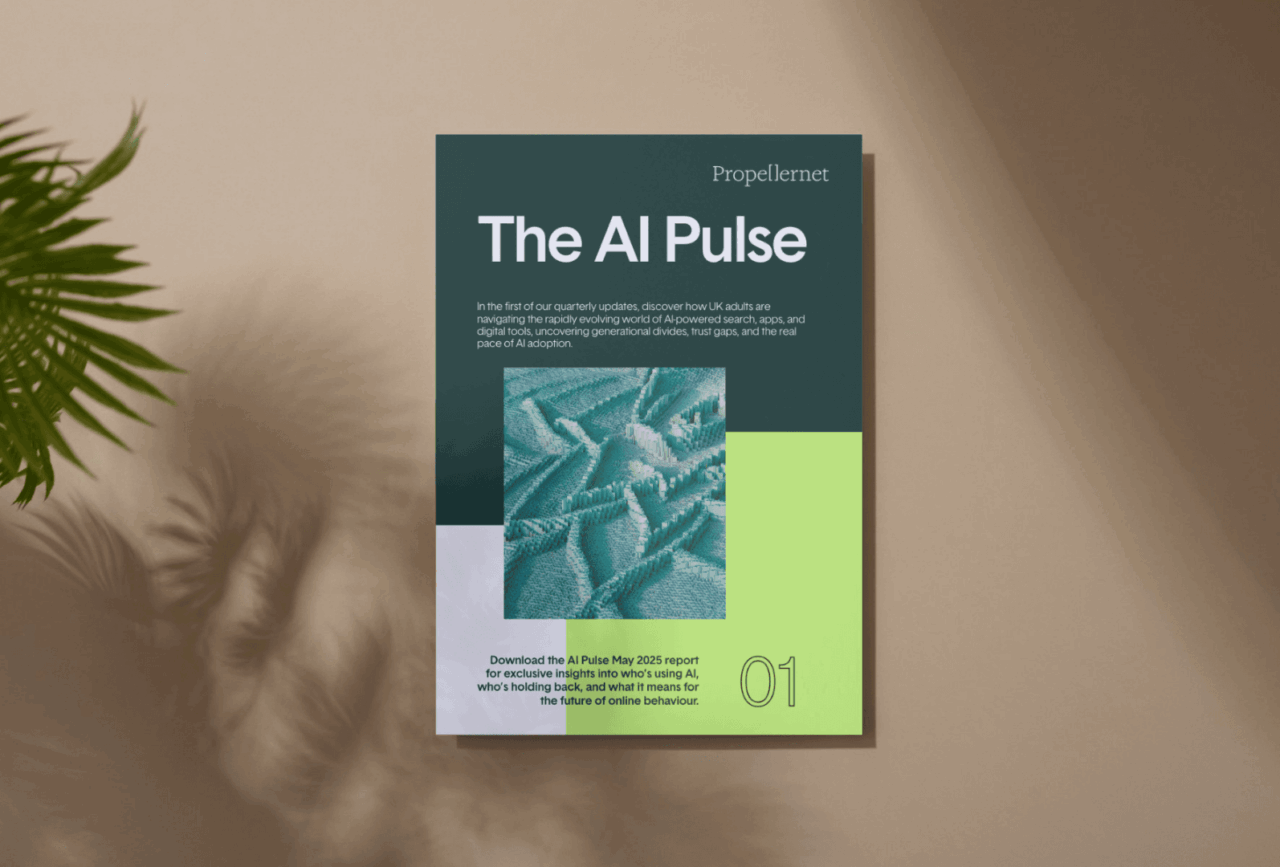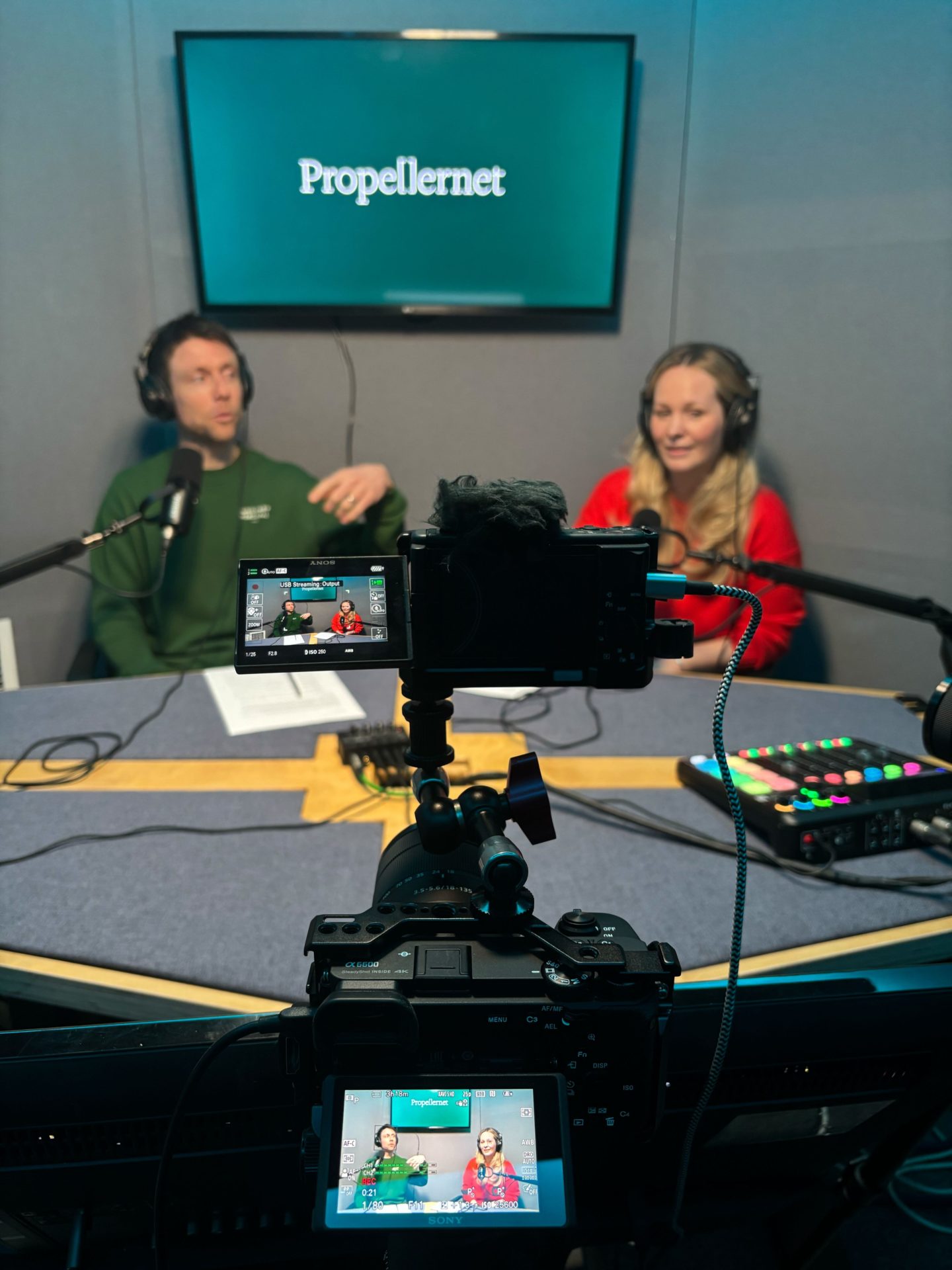
On 29th May, we hosted an exclusive webinar to launch the AI Pulse Report with Sophie Coley and Sam Zindel. We revealed fresh, nationally representative data on who’s using AI tools, who’s holding back, and why. The session explored the generational, regional, and gender divides shaping AI engagement, the trust gaps slowing adoption, and what these trends mean for the future of search, digital behaviour, and marketing strategy.
For real consumer insight beyond the tech hype, enter your details to watch the webinar or read the transcript below.
You can also download your copy of the AI Pulse 01 here.
Simply enter your details and access the full webinar on demand.
AI Pulse Webinar
Sam:
Thanks everyone for joining Propellernet’s AI webinar. This is a new series we’re starting that goes hand-in-hand with a quarterly report we’re producing about AI adoption. I’m sure, like us, your businesses are very interested in the pace of change and how AI is being adopted and changing the way that we work – particularly how it’s changing marketing, especially in search engines and online spaces.
Propellernet has a keen interest in this topic, and it’s been great that Sophie’s put together our first AI Pulse report. Rather than just putting it out there into the world, we thought we’d have a conversation about it, share our thoughts, and give people a chance to ask questions about the insights we’ll be covering over the next 45 minutes.
It’s nice to meet everyone, if I haven’t met you before. My name’s Sam Zindel. I’m Managing Director at Propellernet and I’m joined by Sophie Coley, the author of our AI Pulse report. Sophie is our Director of Strategy and one of the smartest minds at Propellernet, so it’s a real joy to have her with us to talk through the research. So let’s get started.
Sophie, we’re taking a keen interest in AI generally, especially in terms of how quickly things are changing and how different people and businesses are adopting different AI tools. So starting with the basics, can you outline a bit about how we conducted the research and why it matters, particularly for marketers?
Sophie:
Sure! We’ve got printed copies of the AI Pulse report, and we’ll share a link to a downloadable PDF version at the end of the webinar too.
We worked with YouGov to commission this survey, partly to ensure rigour. They helped tighten up the questions and, of course, they provide a reliable and representative sample. We surveyed just over 2,000 UK adults, and the data was collected in April, so it’s about a month old.
There were around ten questions in the survey, covering recognition of AI Overviews in search results, general confidence using AI, trust in AI-generated content, and confidence around using AI for specific tasks. We also cut the data by demographics, which helped uncover some interesting insights.
Sam:
The report is full of graphs, tables, and stats but I particularly liked how you’ve brought it to life using personas. That people-focused angle adds something extra, especially since in marketing, we’re used to thinking in terms of keywords, prompts, and queries – but it’s the people behind those actions that really matter. Could you share a bit about the personas and how they add to the insights?
Sophie:
Yes, absolutely. Before I go into the personas, I want to quickly touch on another reason we did this research.
When AI became more prominent, with ChatGPT emerging and AI Overviews showing up in search, a lot of clients started asking, “How do we show up in AI?” A totally valid question, but I also had this journalism-trained curiosity in the back of my mind: do all clients need to act on this now?
Because different people adopt new technologies at different rates. Some clients’ audiences might not even be aware they’re seeing AI results. So the motivation for the research was understanding people and their behaviours – how they’re actually using AI, or not.
From the survey, we identified three broad groups of AI adoption and brought them to life as personas:
-
Jake Patel is our AI enthusiast. He’s young, works in a digital marketing agency in London, and is already integrating AI into daily life. For him and his peers, using AI is second nature, like checking your phone.
-
Sarah Williams is in the middle. A 30-something mum who uses ChatGPT occasionally, recognises AI Overviews, but isn’t fully trusting. She’s cautiously dipping her toes in.
-
Margaret Ellis represents the AI-illiterate persona – again, perhaps a harsh term. She’s 55+, lives in rural Yorkshire, and doesn’t engage with AI or tech much at all. She goes on Facebook to see photos of her grandkids and that’s about it.
So those three personas (Jake, Sarah, and Margaret) represent different levels of adoption. And this is a journey. Margaret might become a Sarah. Sarah could evolve into Jake. As marketers, we need to understand where our audience is on that journey and tailor our strategy accordingly.
Sam:
That makes perfect sense. And it’s very reminiscent of smartphone adoption patterns. Thinking about this in terms of marketing strategy: how relevant is AI to current marketing channels, based on these user behaviours? What did the generational data tell us?
Sophie:
Great question. We looked specifically at usage of ChatGPT as a benchmark for proactive AI use. Two-thirds of 18–24-year-olds say they use ChatGPT. For those aged 55+, that drops to just 8%.
That’s a huge gap. Again, not surprising given general attitudes toward tech, but it’s stark.
Looking at AI Overviews, which are more of a passive AI interaction (people using Google and being served AI-generated content), we saw that 86% of younger users reported noticing them, versus 41% of older users.
So awareness and confidence clearly correlate. And this matters for brands. If your target audience skews younger, then being visible in AI Overviews should be a current priority.
Sam:
Absolutely. And just for the avoidance of doubt – when we talk about AI Overviews, we mean the new feature in Google search results where an AI-generated response appears at the top of the page, summarising different sources to answer your query. We’ll talk more about those today. It’s a big shift in search, and for those of us working in search engine marketing, it’s the biggest change we’ve seen in a long time.
Sophie:
Yes – and just one more point on the older users. As we mentioned earlier, we’re doing this research quarterly, so we’ll be able to track how quickly adoption changes, especially in older demographics.
At our recent AI Summit, one of our clients talked about how her parents, who are older, are more comfortable using voice search. That could be a softer entry point into AI for that demographic. As tech evolves, it will be really interesting to see how adoption patterns shift, and we’ll be watching that closely.
Sam:
Great. So, awareness is important, but the bigger question is: do people actually trust the information generated by AI? That goes to the heart of its usefulness in marketing. When search engines first launched, there was scepticism about source credibility. Now we’re seeing something similar with AI. And I believe the data shows only a small percentage of users fully trust AI-generated content. Can you talk us through that?
Sophie:
Yes. The headline is: 45% of UK adults say they don’t trust AI outputs. That’s nearly half.
But there’s another clear generational divide. 55% of 18–24s trust AI content, while only 19% of those 55+ do.
It shows that younger people are both using and trusting AI more, whereas older people are less engaged and also less trusting. There’s a loop there: if you don’t use something, you don’t build confidence with it, and then you trust it less.
There’s a visual in the report that maps this out: it shows a cycle of less exposure → less trust → less use. But the reverse is true too. The more you use it, the more confident you become, the more you trust it.
That’s definitely been my journey. I started off sceptical but, with more hands-on use, I’ve found where it’s genuinely helpful. That said, it’s important to retain a critical mindset – always verify content when needed.
I think brands can do a lot to help build trust. One way is being really transparent about how they use AI. For example, publishing an AI policy. If AI has shaped something a customer sees, be upfront about it.
That doesn’t fix the Google issue, where Google pulls content and turns it into AI Overviews, but for your own brand channels, clarity and transparency can really help build trust.
Sam:
Yes, and I think some of the early bad PR, like Google’s AI suggesting people eat rocks, hasn’t helped. A healthy scepticism is a good thing. We know AI can hallucinate, and marketers should help audiences navigate that responsibly.
On that note, with 59% of people noticing AI Overviews but only a small portion fully trusting them — how are users actually interacting with those results? And as marketers, should we be trying to play in that space and aim to be visible there?
Sophie:
It’s a great question. First, about a quarter of UK adults say they don’t notice AI Overviews at all. But that might not reflect reality. We’ve seen client data showing declines in traffic even when rankings are stable.
That implies people may be seeing AI Overviews, but either don’t recognise them or are getting their answers there without clicking through. So when 25% say they don’t notice them, it might be more about awareness than actual exposure.
That’s one challenge with self-reported data. If someone doesn’t know what an AI Overview is, they may not realise they’re seeing it, even if they are.
Now, in terms of showing up in those results – we think digital PR will be key. Having your brand referenced across the web in high-quality places helps. Brand presence is likely to be even more important than links alone.
From a content perspective, this is an opportunity to move beyond generic content and get really specific. Understand the micro-needs of your audiences. For example, instead of “marathon training plan,” write one tailored for “a commuting, sleep-deprived parent of a newborn.”
There may not be current search demand for that exact query, but as users get better at prompting, they’ll expect AI to serve them something that meets that level of specificity. Brands that anticipate and cater to those niche needs are more likely to show up in AI Overviews.
Sam:
Totally agree. And there’s some research out there showing that while AI Overviews might reduce click-throughs in some cases, they can also increase direct traffic. If your brand is named in the Overview, people might remember it, pause their journey, and then search for you directly later.
That’s a positive trend, and one we’ll continue tracking. Let’s shift gears now. We’ve talked a lot about age differences, but your report also highlighted a gender divide in AI adoption. Could you share some of that?
Sophie:
Yes, and honestly, it was disheartening. 29% of men said they use ChatGPT, compared to just 22% of women. It’s not a massive difference, but it’s statistically significant.
We also saw a gap in confidence levels. Men are more likely to say they feel confident using AI tools. I don’t want to speculate too much on the “why” behind that, but it reflects broader trends we’ve seen in tech usage.
That said, it’s not something we should accept as inevitable. I hope to see initiatives aimed at helping women build confidence with AI. It’s a powerful tool and the gap shouldn’t exist.
Sam:
Absolutely. And I think that confidence issue really resonates. With any new tech, there’s always a learning curve. But if one group feels more confident just jumping in, they’re more likely to get the benefits early.
Sophie:
Exactly. And there are creative applications of AI that might help here. I recently discovered a tool called Runway, where you can animate old family photos – I used it on one of my grandparents. It was really moving.
There are also tools for illustrators, where you can upload your artwork, and AI can generate new images in the same style. These kinds of use cases might appeal more broadly and feel more accessible.
Sam:
Let’s now take a quick look at regional patterns. I think it’s probably not a shock that London and the Southeast are early adopters, but could you share a bit more on what the data shows?
Sophie:
Yes. So this one overlaps slightly with the confidence data too. 51% of people in London had used ChatGPT, compared to a national average of 26%. That’s a huge gap.
And when we looked into it further, we realised that this divide is even more extreme than with previous technologies, like smartphones or broadband, where you’d also expect London to lead, but not by this much.
I think this comes down to demographics. If you go back to our personas, Jake lives in London. He’s young, working in a digital industry, and that’s the type of person more likely to try out AI. London naturally has a higher concentration of that group.
By contrast, Margaret, who’s not engaging with AI, is based in rural Yorkshire. So the regional divide fits with the persona divide too.
But this is something we’ll track over time. This is “wave one” of our research – it’s our benchmark. In future waves, we’ll see if the rest of the country starts to catch up.
It’s interesting – the UAE just announced they’re giving every citizen a pro licence for ChatGPT in a national push for adoption. That kind of initiative could really move the needle. It’ll be interesting to see if the UK follows suit in any way.
Sam:
Yes and what’s fascinating is that AI is often talked about as the great leveler. It can democratise access to skills, tools, and knowledge, especially with free versions available to anyone with a smartphone. So it’s surprising to see that adoption gap between London and the rest of the UK, despite the barrier to entry being relatively low.
Maybe that’s something we need to explore more deeply in the next round of research – what’s actually preventing people from using these tools?
Switching gears again, I want to talk about ChatGPT and Google. We used them as shorthand for two sides of the search landscape: traditional vs. generative. As marketers, there’s been a lot of speculation that LLMs like ChatGPT are “stealing” market share from Google. But your data suggests the reality is a bit more nuanced, right?
Sophie:
Yes. It’s really interesting. In our survey, 77% of people said they use Google each month – no surprise there. But only 26% said they use ChatGPT.
So while AI tools are rising, Google is still dominant.
We dug a bit deeper into use cases too. We asked people about their behaviour in specific contexts: information seeking, travel planning, and purchase research. We wanted to understand when people were turning to Google versus AI tools.
Let’s take travel planning as an example. Only 6% of UK adults said they used an AI tool for travel planning, versus 40% who said they used Google.
That surprised me because I personally use ChatGPT for travel inspiration. I’ve even built a custom GPT that knows the types of holidays I like. But clearly that behaviour hasn’t gone mainstream yet.
Sam:
That is surprising, but it does show how early we still are in this shift. It probably comes down to what people know is possible. AI can do a lot, but if people don’t realise how to prompt or where it fits in their daily lives, they won’t use it.
Sophie:
Exactly. It’s partly an education issue. And even within ChatGPT, the design doesn’t necessarily guide you to what it can do. If you type a search-like phrase, you might not get a very helpful result.
Prompting is a skill. If you try to use ChatGPT like a Google search bar, it won’t perform well. And if your first experience isn’t great, you’re unlikely to come back. So there’s a learning curve there, and it’s probably a big factor in slower adoption.
And just a side note: while AI use in search is growing, I don’t think we’re seeing a full takeover. It’s not AI or Google, it’s both. You might start on Google, jump into ChatGPT, then back to Google. The behaviours are overlapping.
Sam:
Yes and I think Dave, our Head of Tech SEO, made a good point recently. He said it’s not that AI tools are “taking share” from Google. They’re just adding more digital behaviour. People are spending more time online overall, and they’re just adding ChatGPT into the mix.
Now, we’ve also been watching how Google itself is changing. They recently launched “AI mode” in the US, basically a full AI-first version of the search engine. But it still doesn’t feel very well engineered in terms of the user journey to purchase.
Traditional search still outperforms when it comes to driving transactions. The current AI setups are better for research, not so much for conversion. Would you agree?
Sophie:
Completely. That purchase journey isn’t smooth in most AI tools yet. Shopping functionality is limited, or not even available, in many cases.
OpenAI have said shopping features are rolling out in the UK, but I haven’t seen them in action. Perplexity’s shopping feature is US-only at the moment. So we’re not quite there yet in terms of AI tools being viable conversion platforms.
But that could change fast. And when it does — especially if ads are introduced — it’s going to shift user behaviour again.
Sam:
Absolutely. And there’s a whole conversation to be had about advertising in generative tools. It’ll be fascinating, especially if it starts to feel too personalised or intrusive. Let’s circle back to how people are using these tools now.
Did the data reveal much about how ChatGPT is being used for actual purchases, or more commercial searches?
Sophie:
Yes. We asked people about that directly. Around 20% of UK adults said they use ChatGPT for general information seeking, which makes sense. That’s quite a broad and accessible use case.
But only 6% said they use it to help them make purchases. That’s low, and I think it reflects the current limitations. Like we said, the shopping functionality isn’t well-developed yet in most tools, especially outside the US.
But I do think that will change over time – especially once advertising becomes part of these tools. That’ll really shape how they’re used.
I had a conversation on LinkedIn recently with someone about this, about how advertising in a chatbot might feel quite different to traditional formats. It could feel… unsettling. Because you’re in a conversational interface that feels quite human, and suddenly an ad is dropped into the experience. It changes the tone.
It reminded me of an episode of Black Mirror, actually, the one where a woman subscribes to a service that resurrects her dead partner via AI, and at one point, he starts spouting adverts without realising it. It’s creepy because it crosses that boundary between utility and manipulation.
So while generative ads could be useful, they’ll need to be handled carefully to avoid damaging trust.
Sam:
Yes, that makes sense. Every month, there’s something new, so we’ll definitely be watching that space.
As we wrap up, I wanted to ask: what surprised you most in the data? And what’s your number one takeaway for everyone here?
Sophie:
The thing that moved me most, although it wasn’t the biggest surprise, was the gender gap. I just didn’t want to see it, to be honest. It was disappointing. The age and geography divides made sense, but I’d hoped gender adoption would be more balanced.
The other big takeaway was that cycle we talked about earlier – how lack of exposure to AI leads to lower trust and lower use, which just reinforces the gap. It’s a self-fulfilling loop.
We’ve included a diagram of that in the report, showing how confidence and trust are built through usage, but also how a lack of exposure leads to fear or disengagement.
That’s been my journey, too. When we had our first ChatGPT training in November, I was a bit unsure. Now, I use it all the time and find loads of creative and productive applications for it. There’s still a bit of overwhelm, of course, but I’d say excitement is the main emotion now.
So my hope is that more people across the UK will go on that same journey – from scepticism to confidence.
Sam:
Brilliant. Thanks for sharing all of that, Sophie. Just a reminder for everyone – we’ll be sending out the link to the full report so you can explore the data for yourself. Please feel free to reach out to us if you want to discuss anything we’ve covered here.
We’ll also be repeating this research quarterly, so there’ll be future webinars and updates as we track the pace of AI adoption in the UK.
Before we sign off, we’ve got a bit of time for questions. The easiest way is to pop them into the chat – we’ll read them out and answer them live.
OK, we’ve got one coming in: “Have you played around with the paid LLMs? Are they much more advanced than the free ones?”
Sophie:
Yes, we’ve got pro licenses for both ChatGPT and Perplexity. I really like Perplexity Pro, especially for research-heavy tasks. It’s very transparent about how it reasons and structures answers.
The main benefit of the paid versions is that you get access to more advanced models and fewer usage caps. For example, you can do more complex logic and run more queries without hitting limits.
Also, with paid versions, you’re automatically moved onto the latest model releases. The older models are still good, but the new ones are noticeably better, especially in reasoning tasks.
Sam:
Yes, and there’s a big data privacy benefit too. With paid versions, you can opt out of having your inputs used for training. That’s important for us as an agency as we don’t want sensitive client data going back into the training pool.
Sophie:
Yes, exactly. And just a note, Perplexity Free also has a privacy toggle, which is great if you’re working on something sensitive and still want to use the tool.
Sam:
Good point. Alright, I think that’s everything. Thanks so much for joining us today. Keep an eye out for the report download link, and we hope to see you again at the next session as we keep tracking AI’s impact on marketing.
Sophie:
Thanks, everybody!






